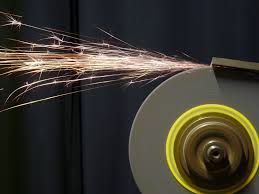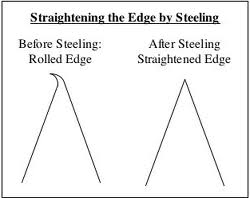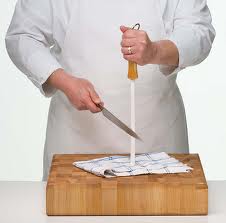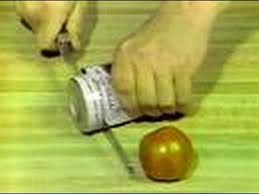You don’t need to have your knives professionally sharpened. Perhaps if you’ve been using it as a machete against trees or concrete, you might need to have someone with a grinding wheel look at it, but that’s not what most people do with their kitchen knives. The typical household blade doesn’t get the use and abuse that professional kitchens exert on their knives, so simple maintenance will keep it sharper and safer if you use your knife correctly.
 Having your knife professionally sharpened means removing material from the blade. The knife is ground down by the process. However, this is often too drastic a remedy for what is really going on with your home kitchen knife. A truly “dull” knife is flat on the edge, it no longer has a point. This is a candidate for the grinding wheel because a new point must be created.
Having your knife professionally sharpened means removing material from the blade. The knife is ground down by the process. However, this is often too drastic a remedy for what is really going on with your home kitchen knife. A truly “dull” knife is flat on the edge, it no longer has a point. This is a candidate for the grinding wheel because a new point must be created.
But, this is not the issue with the majority of knives. Most people deny the fact that a dull knife is more dangerous than a sharp knife. A well maintained blade will cut effortlessly through food. One that is not kept in good condition will drag through items, requiring you to press harder and apply more force. This is usually when the knife slips and you cut yourself. A sharp knife never needs to have excessive pressure put on it, and when used correctly is the safest tool in the kitchen.
 The typical issue with your kitchen knife is that it develops “burrs”. These are tiny splinters where then edge has become frayed or flattened in spots. A knife with burrs will create friction and drag through items, making it more dangerous. Solving this problem doesn’t require the removal of material as if it were dull. The knife needs to be “re-trued”.
The typical issue with your kitchen knife is that it develops “burrs”. These are tiny splinters where then edge has become frayed or flattened in spots. A knife with burrs will create friction and drag through items, making it more dangerous. Solving this problem doesn’t require the removal of material as if it were dull. The knife needs to be “re-trued”.
The sharpening steel is used to re-true a knife. It doesn’t remove material like a sharpening stone, but will remove the burrs that slow the knife down and cause you to force it. When a knife is correctly steeled, it will be easier to use and you’ll have avoided a knife sharpening charge.
 Flashing the sharpening steel around like a Japanese Chef may look cool, but it accomplishes little. The correct way to remove burrs using the steel is to set it at a 90 degree angle against a table and pull the knife across it in a concerted fashion. I often imagine a stringed instrument and the knife is the bow. A 20 degree angle is preferred when using this method.
Flashing the sharpening steel around like a Japanese Chef may look cool, but it accomplishes little. The correct way to remove burrs using the steel is to set it at a 90 degree angle against a table and pull the knife across it in a concerted fashion. I often imagine a stringed instrument and the knife is the bow. A 20 degree angle is preferred when using this method.
Pull the blade across the steel at least 5 times on each side of the knife and you’ll have re-trued your knife. But, if it is still dull, you may need the help of a sharpening stone. For just a few bucks at the local hardware store, you can purchase a small stone that will gently grind material off and bring back the edge.
 Holding the knife at a 20 degree angle against the stone, pretend you are trying to cut thin slices. Five times on one edge, five times on the other edge, and then repeat on the finer-grit side. This will be more dramatic than the steel, but will help return your knife to usable condition if it has been cutting shoes or tin cans like on late night TV.
Holding the knife at a 20 degree angle against the stone, pretend you are trying to cut thin slices. Five times on one edge, five times on the other edge, and then repeat on the finer-grit side. This will be more dramatic than the steel, but will help return your knife to usable condition if it has been cutting shoes or tin cans like on late night TV.
There’s even a correct way to wipe your knife when you’re done. Please don’t cut through a towel into your own hand. Trust me, you’ll only do that ONCE. I know from experience. Place a towel on the table. Place the knife on the towel and fold it over to cover the knife. Apply pressure from above and pull the knife out of the towel to wipe it without coming in contact with your hands.
Have you used your sharpening steel? Give me a Yes or No in the comments below:
I’ll bet most people have one in their homes and don’t know what it is for.

Oops! Didnt follow directions before…yes, I was given a steel for our wedding. Didn’t know how to use it before now. Thanks!!
Thanks, Chef Todd, for making all these videos and teaching with such passion! You make learning to cook fun and interesting! My husband and I both like the results and we look forward to adding more methods to my capabilities!
Hi Donna!
Thank you for the kind words. In WebCookingClasses, we focus on the HOWs and WHYs, the standard, repeatable, reliable, dependable METHODS in cooking that puts the power to create, not just cook, back in your hands.
Dad used to sharpen his knives as shown in your video, a little obsessively. Even the butter knives could remove silverskin. LOL, no expensive stones used but just the one that Dad used to use.
Hi Pati!
Yes, my Grandfather was the same way. He spent more time sharpening the knife than he did actually cutting with it. The knife only needs to be sharpened 2-3 times a year in my opinion, unless you’re doing a LOT of work on hard products. It certainly doesn’t need to be sharpened before EVERY use!
This is great! I have been looking at steels and the prices are all over the place. Ceramic, carbon steel, 8″ 17″… Since you’re moving the knife along the steel I don’t need something real long correct? I’d only need one long enough to accommodate the width of the knife. And whetstones? Eegads! All kinds of grit from 300 to 6000 – use oil, use water, It’s grown into a whole industry. It all looks pretty unnecessary when you can get a “old fashioned” whet stone for a few bucks! This is a great video! Really helps me to look in the right place for the right tools. Thanks Chef Todd! You’re Awesome!
Hi Wendy!
Yes, there are plenty of fancy gadgets that cost hundreds of dollars that can sharpen your knife. There’s also plenty of non-fancy non-gadgets that are quite cheap that accomplish the same thing.
What about the Wal-Mart type that has 2 steel rings that you pull the knife through? Good or bad?
Hi Robert!
I’m unfamiliar with the “Wal-Mart type that has 2 steel rings that you pull the knife through” so I can’t comment.
I have heard that the steel should be of the same alloy and hardness as the knives. Is there any truth to that?
Hi John!
No, that’s not true. If the sharpening steel were made from High Carbon Stainless Steel, it would cost more than your knives.
Hi Chef Todd, thank you for reply.
I’m using German Wusthof or Portuguese Ivo – based on my mood
Honing my knifes after every usage. I do it religiously. That keeps them in shape. Twice a year or so – use my stone. Nothing fancy
Hi Igor!
If you have a good quality “high carbon stainless steel” knife, all that steeling is unnecessary. Cheaper and softer carbon steel may need to be honed more often, but a good knife with hard steel should keep its edge for weeks or months.
Yes, I do. What a difference it makes to hone my knife before I use it.
Hi Carol!
A dull knife is much more dangerous than a sharp knife. I’m glad you keep your tools in good shape. Better cooking always results.